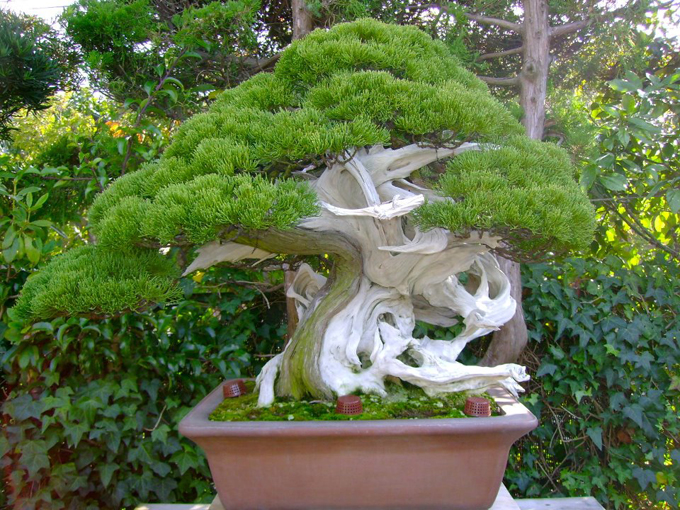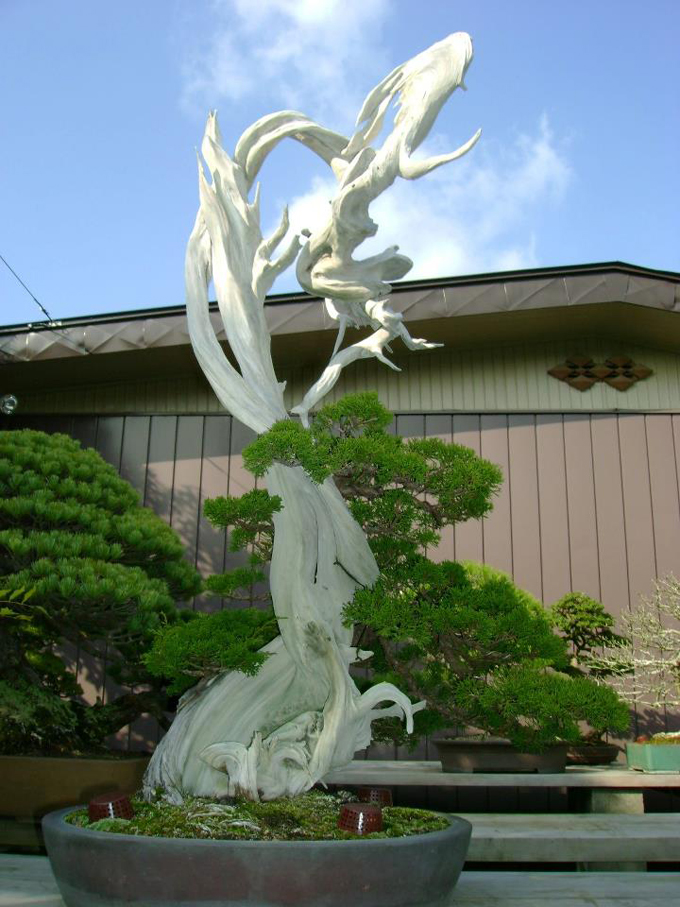 Here’s a Kimura tree that I’ve never seen. This, and the other photos in this post are from Owen Reich on facebook. Owen lives in Japan and takes bonsai photos. In addition to his facebook offerings Owen has a blog that is rich with excellent photos.
Here’s a Kimura tree that I’ve never seen. This, and the other photos in this post are from Owen Reich on facebook. Owen lives in Japan and takes bonsai photos. In addition to his facebook offerings Owen has a blog that is rich with excellent photos.
Not so naturalistic
It’s not my intention to reopen the old naturalistic versus sculptural bonsai debate. It’s just that when you look at some of Masahiko Kimura‘s bonsai, the question seems to arise on its own; his highly refined deadwood-dominant bonsai stand in contrast to what you find in nature. Beyond that, I don’t know if more needs to be said, other than Kimura’s bonsai are truly mind blowing and that there’s no real need to draw lines and take sides.
Kimura’s Garden 2008
Here’s what Owen says about the photos that he posted under the title Kimura’s Garden 2008: “Photos really do not do justice to Kimura-san’s bonsai. The depth and complexity is lost a little in photos.” I second that sentiment. No photo of any bonsai anywhere, ever captures the sheer power that a world class bonsai conveys when you see it in person (come to the 3rd U.S. National Bonsai Exhibition and see for yourself).
 This undulating pine is no doubt a little closer to the way it was found in nature than the other trees shown here. In general, Kimura treats pines quite differently that junipers and some others.
This undulating pine is no doubt a little closer to the way it was found in nature than the other trees shown here. In general, Kimura treats pines quite differently that junipers and some others.
 This looks like a Hinoki. My semi-educated guess is that Kimura built the rock (you can see how in our book The Magician, the Bonsai Art of Kimura 2).
This looks like a Hinoki. My semi-educated guess is that Kimura built the rock (you can see how in our book The Magician, the Bonsai Art of Kimura 2).
 NEW. Masters’ Series Set of three of our most popular bonsai books. Each one features bonsai step-by-step by Masahiko Kimura (Pine & Junipers feature other artists as well). Each is also available individually.
NEW. Masters’ Series Set of three of our most popular bonsai books. Each one features bonsai step-by-step by Masahiko Kimura (Pine & Junipers feature other artists as well). Each is also available individually.


Hi Wayne,
Great post. Ive seen deadwood every bit as wild as that on Kimura Sans bonsai, and while those trees didn’t have a refined crown, Kimura sans work EVOKES the image of those trees in my mind. No matter the school, naturalistic or refined, sculptural or wild, bonsai are by necessity idealizations of trees, and as such, if they evoke the image presented by the artist, then they are great bonsai. Hopefully this schism can be put to rest sooner rather than later.
And check out that guy in the background of the hinoki mountainscape…I swear I’ve seen that guy somewhere…so familiar…for an interesting view of this hinoki planting 5 years ago, versus where it is today, check out Joes excellent blog post here:
http://bonsaijapan.files.wordpress.com/2007/07/11-116a.jpg
Hi Ryan,
Thanks for your insights.
I guess I’m a little guilty of keeping the imaginary schism alive just by mentioning it.
However, I think it can be informative to understand different views about what it means to idealize trees and how to go about doing that. Maybe rather than schisms, we could just say that the various views and approaches represent different schools of bonsai.
Hi Ryan,
Yes, better view of the same planting. Thanks.
And yes, I suspect you have seen him somewhere.
Agreed Wayne. When it’s looked at as differing schools, I see no issue t’all! As in the rest of the art world, is a great natural landscape better than a impressionistic one by Monet? Of course not, simply a difference in style and school. Kimura’s creations may be outlandish, even surrealist, but it’s important that they evoke in the viewer a tree struggling against the harshness of its surrounding. In this sense, a Bonsai need not look like any real tree at all, as long as the viewers impression of a aged tree telling the story of its surroundings. A bit Platonic, but much of art is.
Thanks again Ryan,
I’ve felt all along that if we are going to call bonsai an art, then we need to put preconceptions aside.
I agree with your notion of a tree telling a story (of its surroundings) but I might even questions statements like ‘it’s important that they evoke in the viewer a tree struggling against the harshness of its surrounding.’ Not that that notion isn’t often helpful, but you could take another view, perhaps representing a tree that has grown in more hospitable surroundings.
Or…?
Wayne,
I was only referring to Kimuras deadwood style trees with the “harshness of their surroundings” bit. Certainly many other “styles” evoke other, more hospital surroundings, and are just as valid!
Wayne,
I was only referring to Kimuras deadwood style trees with the “harshness of their surroundings” bit. Certainly many other “styles” evoke other, more hospitable surroundings, and are just as valid!
Ryan,
Aha. Thanks.